Gin Gliders Atlas M |
|||||||||||||||||||||||||||||||||||||||||||||||||||||||||||||||||||||||||||||||||||||||||||||||||||||||||||||||||||||||||||||||


|
|||||||||||||||||||||||||||||||||||||||||||||||||||||||||||||||||||||||||||||||||||||||||||||||||||||||||||||||||||||||||||||||
Instability rating |
|||||||||||||||||||||||||||||||||||||||||||||||||||||||||||||||||||||||||||||||||||||||||||||||||||||||||||||||||||||||||||||||
|
|||||||||||||||||||||||||||||||||||||||||||||||||||||||||||||||||||||||||||||||||||||||||||||||||||||||||||||||||||||||||||||||
Glider characteristics |
|||||||||||||||||||||||||||||||||||||||||||||||||||||||||||||||||||||||||||||||||||||||||||||||||||||||||||||||||||||||||||||||
|
Launch preparations: average
launch characteristics: balanced, climbs constantly, no guidance necessary, good feedback during inflation, moderate braking required, control check simple, low takeoff speed
asymmetric collapse: moderate dynamics, total course change 270-360°, (4), marked forward pitching 60-75°, (4), very high height loss 50-59 m, (4), moderate sink velocity 15-19 m/s, (2), G-Force < 2,5 G, (1)
Frontal collapse: canopy collapses with high total collapse aera, moderate pitch backwards 30-45°, marked pitch forwards 45-60°, moderate dynamics, variable recovery behaviour, at times with stable closed frontal collapse, at times with automatic recovery, (4), asymmetric recovery, simple pilot action required, (4), horseshoe, wingtips at front, with tendency to cravat, (4), high height loss 40-49 m, (3), moderate sink velocity 15-19 m/s, (2)
Spiral dives: rapid sink velocity increase, Moderate G-Force 3,5- 4.0 G, (2), Sink velocity after 720° <18 m/s, (3), High maximum sink velocity < 22 m/s, (3), sink velocity increase < 3 m/s on brake release, (1), Course change 360-540° after spiral exit, (3), high height loss during recovery 60-100 m, (3)
B-Stall: normal force required, marked pitch backwards 30-45°, moderate pitch forwards 15-30°, stable sink phase, no tendency to deform, immediate return to normal airspeed, 8-10 m/s, height loss on recovery < 20 m
big ears: simple initiation, stable flight phase, wingtips flatter a little, delayed automatic recovery, Vsink unaccelerated 3,5-4 m/s, Vsink accelerated 4-4,5 m/s, Vunaccelerated 3-5 km/h less than trimspeed, Vaccelerated 5-8 km/h faster than trimspeed
Steering behaviour: balanced to agile, 70 cm brake travel range, very noticable brake pressure increasse, Late stall point, easily identifiable |
|||||||||||||||||||||||||||||||||||||||||||||||||||||||||||||||||||||||||||||||||||||||||||||||||||||||||||||||||||||||||||||||
Notes |
|||||||||||||||||||||||||||||||||||||||||||||||||||||||||||||||||||||||||||||||||||||||||||||||||||||||||||||||||||||||||||||||
|
en: Seitliche Einklapper: moderate Dynamik, aber zögerliches Öffnen und dadurch größerer Höhenverlust. Frontales Einklappen: Indifferentes Verhalten, schnelle Öffnung und verzögerungsfreies Anfahren bei Frontklappern bis 40%. Bei größeren Frontklappern starke Tendenz zum Abknicken in Flügelmitte, Umschlagen nach vorne, mit Verhängertendenz, teils aktive Ausleitung erforderlich. Bei maximaler Einklapptiefe, sehr weites Abkippen, meist schnelle, selbständige Öffnung bei deutlichem Vorschießen. Steilspirale: Relativ dynamisches Verhalten, deutliches Nachdrehen, dadurch größerer Höhenverlust bei der Ausleitung. B-Leinen-Stall: einfach und gutmütig Ohrenanlegen: Ohren schlagen beschleunigt leicht, sehr zögerliche Wiederöffnung |
|||||||||||||||||||||||||||||||||||||||||||||||||||||||||||||||||||||||||||||||||||||||||||||||||||||||||||||||||||||||||||||||
Rating |
|||||||||||||||||||||||||||||||||||||||||||||||||||||||||||||||||||||||||||||||||||||||||||||||||||||||||||||||||||||||||||||||
|
Safety class 4 This class of paraglider reacts demandingly to one or more of the following manoeuvres: frontal collapse, asymmetric collapse or spiral dive.Demandingly means that the above manoeuvres result in marked dynamic reactions from the glider and/or large height losses. Advanced piloting skills which need to be regularly practised, together with good personal reaction times are required to safely fly this class of gliders. Basic recovery techniques for ending a manoeuvre are not sufficient to maintain control, reduce height loss to a minimum and prevent subsequent critical reactions. Pilots should be able to recognise the onset of the above manoeuvres and be able to prevent or minimise their effects through immediate and precise pilot inputs. Additional experience such as regular ground handling and SIV training is required to safely fly gliders of this class. Special training or pilot skills which exceed standard training may be required for the safe performance of emergency descent techniques. Gliders of this Safety Class are not suitable for beginners, irregular flyers or low-airtime pilots. |
|||||||||||||||||||||||||||||||||||||||||||||||||||||||||||||||||||||||||||||||||||||||||||||||||||||||||||||||||||||||||||||||

